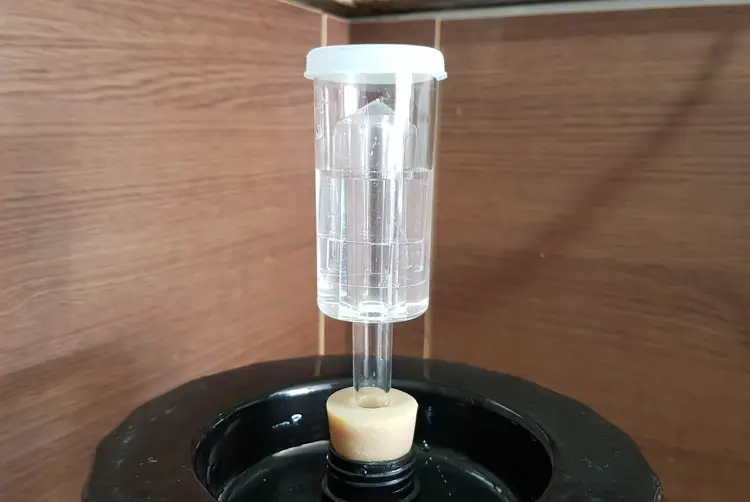The airlock is one of the most important pieces of equipment for home brewing. New homebrewers may get overwhelmed by the choices, worry about the process, or forget this critical piece of equipment. Properly using and maintaining an airlock through the fermentation process is key to great results in the finished product.
An airlock is vital to a successful homebrew. A quality airlock will:
- Keep a sterile seal on your brew
- Allow gasses from fermentation to be released
- Prevent the fermenter from exploding
- Prevent wild yeasts, bacteria, dust, or pests from contaminating the finished product
We’ll explain more about different airlocks, how you should use an airlock, and what you can do in a pinch if you don’t have one on hand.
Why Do You Need an Airlock?
During the fermentation process, the yeast eats sugar to produce alcohol and carbon dioxide.
Carbon dioxide bubbles rise through the liquid wort or must, into the air space above the liquid. Over time, the carbon dioxide builds up, increasing pressure in the fermenter.
Without an airlock, there is nowhere else for the carbon dioxide to go, continuing to increase the pressure in the fermenter.
Each fermenter has a maximum amount of pressure that it’s able to withstand.
If the pressure inside the fermenter builds up too much, any lid or cap might pop off.
If the lid is firmly held in place and is able to withstand more pressure than the fermenter itself, there is a possibility that the fermenter could rupture.
The fermenter typically will have a lid, cap, or other stopper, to prevent outside air from getting into the vessel.
Ambient air is typically contaminated with dust, pollen, dirt, wild yeast, bacteria, and other contaminants.
These contaminants can spoil a whole batch.
Brewers needed a way to keep the unclean air out of their fermenters while allowing the gasses that build up inside to make their way out.
Airlocks also prevent oxidation
Oxygen in the air can ruin an entire batch of beer.
Oxidation can cause the beer to taste stale, bitter, or even “skunky”.
Even if the brewer thinks that the air quality around their fermenter may be safe from wild yeasts and bacteria, it’s important to use an airlock to prevent the air from spoiling the beer while it goes through fermentation over several weeks.
Similar to how you wouldn’t leave a bottle of wine or a soda open for days before drinking, don’t leave your beer brewing without an airlock.
Most airlocks are made with clear materials, such as food-grade plastic.
This allows the brewer to see inside the airlock, which could be handy to ensure nothing has gotten inside the airlock, but also to observe visible signs of fermentation.
Bubbles in the airlock
Bubbles rising up through the airlock may indicate your wort or must is fermenting.
Fast bubbles may indicate a fast fermentation, while slow bubbles may indicate a slow fermentation.
If you don’t see any bubbles at all, your fermentation may have stalled.
However, an absence of bubbles does not automatically mean that fermentation has stopped or is complete, and the presence of bubbles may not indicate that fermentation is occurring.
Making that assumption should be cautioned, as bubbles merely indicate that pressure is building up inside the fermenter.
There are many reasons why the presence of bubbles, or lack of bubbles, may not be good reading for fermentation.
Temperature can impact the amount of carbon dioxide that can be dissolved in the wort.
If the temperature rises, the carbon dioxide will expand, increasing the number of bubbles coming through the airlock, even if fermentation is almost over.
This is also a good reason why an airlock is important even during low activity stages of fermentation, as thermal expansion and contraction can only be accounted for with a device that will compensate for that expansion.
In this video I uploaded on Youtube, you can see the bubbles happening only after 12 hours :
Different Types of Airlocks
All airlocks have one thing in common. The intent is to allow gasses from fermentation to escape from the fermenter while keeping contaminants out of your homebrew.
However, there are two basic types of airlocks where each design has its pros and cons.
One type is an s-shaped airlock, and the second is a three-piece airlock.
S-Shaped Airlock
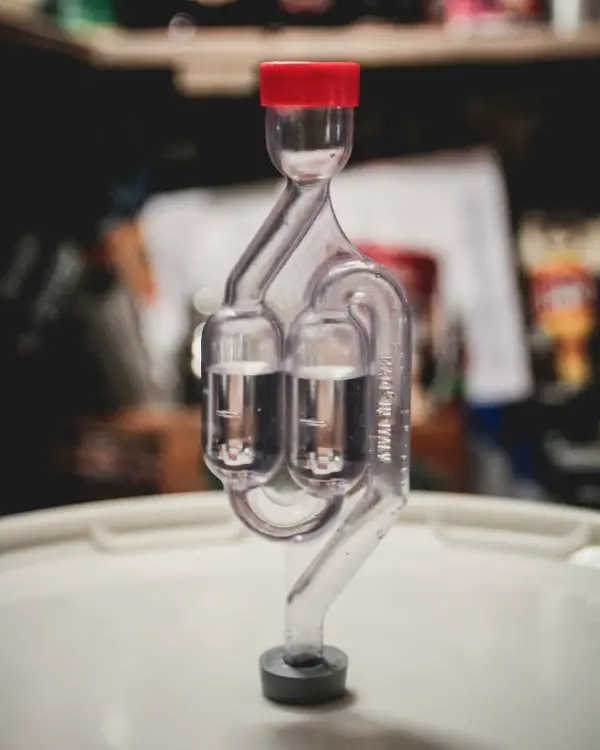
The s-shaped airlock consists of a single piece, typically plastic, with an s-shape.
This type of airlock is one of the original designs for modern homebrewers.
You fill part of the airlock with sterile water or sanitizer to create a barrier between ambient air and your wort or must.
As gasses build up inside of the fermenter, bubbles will rise up through the water, through the s-shape, then out of the top of the airlock.
Airlocks work due to gravity and the pressure of the air around us.
Ambient air has a pressure of about 14.7 psi, or pounds per square inch. As the pressure of the air presses down on the water level in the airlock, the pressure in the vessel pushes back up through the stem. As the pressure builds up inside the airlock, bubbles will start to rise up through the water. Since ambient pressure rarely fluctuates substantially, unless due to extreme weather events, the water keeps outside air from penetrating through the water or liquid barrier.
Some brewers prefer the s-shape airlock, believing that in this design, negative pressure or suction in the fermenter won’t be able to suck water back into the wort or must.
However, other brewers believe that this type of airlock is very difficult to clean. On occasion, your wort of must may over ferment, pushing debris up into the airlock. You have to use pipe cleaners to clean out the middle of the s-shape if anything gets lodged in there.
No products found.
Three-Piece Airlock
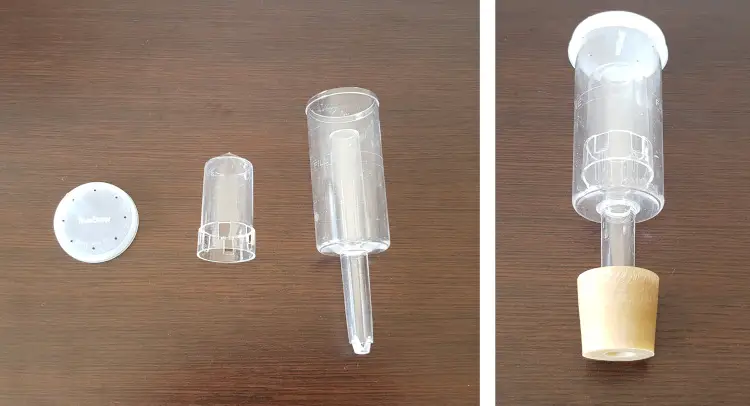
The three-piece airlock is a newer design that is preferred by many homebrewers.
In this design, the airlock consists of three pieces:
- a base with a stem
- a piston
- a vented cap.
The brewer would add sterile water up to a certain fill line in the base, then place the piston, opening side down, on top of the stem, with a cap on top.
As gasses build up in the fermenter, the bubbles rise up through the stem, through the piston, and out the bottom of the opening of the piston. The bubbles then rise up through the water and out the vented cap.
Many homebrewers prefer the three-piece design for how easy it is to clean. In the case of over foaming from fermentation, the airlock can be pulled off, each piece cleaned individually, then replaced.
No products found.
How to Use an Airlock Correctly in Homebrewing
So, how do you actually use an airlock?
The intent of the airlock is to create an air proof seal between the contents of your fermenter and the ambient air around it.
To do this, you’ll need a lid, cap, or stopper for your fermenter’s opening.
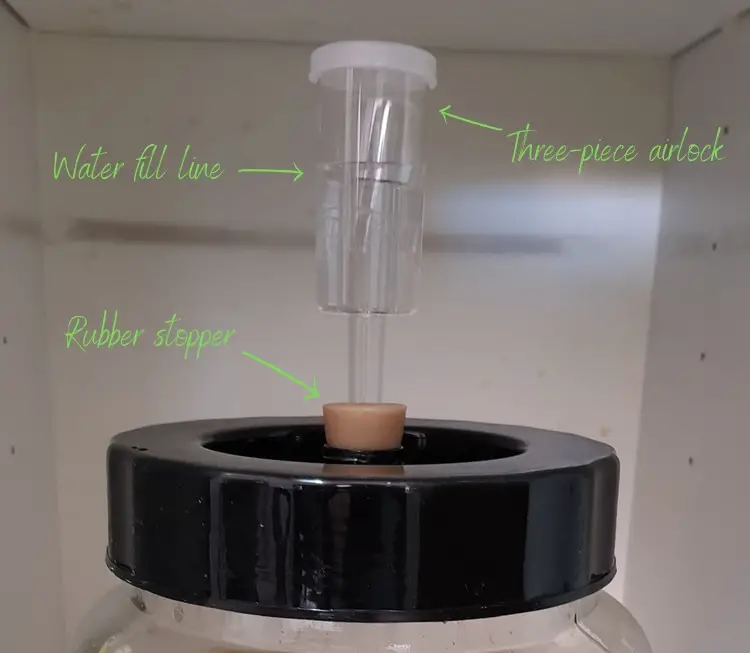
Capping the Carboy
Some glass carboys have a mouth that looks like a milk jug.
These types of mouths need a rubber stopper with a hole in it.
The stem of the airlock should fit snugly into the hole of the stopper, then the stopper securely into the mouth of the fermenter.
The rubber stopper should not pop back out when you insert it into the opening. If it does, the stopper may be too big.
Fermenters with wide mouths may need special lids to allow you to insert an airlock. These lids might be plastic lids with a small gasketed hole in them. These lids screw onto the mouth of your fermenter, and then the airlock stem is inserted into the gasketed hole.
Regardless of method, all the pieces should be snug and secure.
If any of the pieces move around, there may not be a good enough seal.
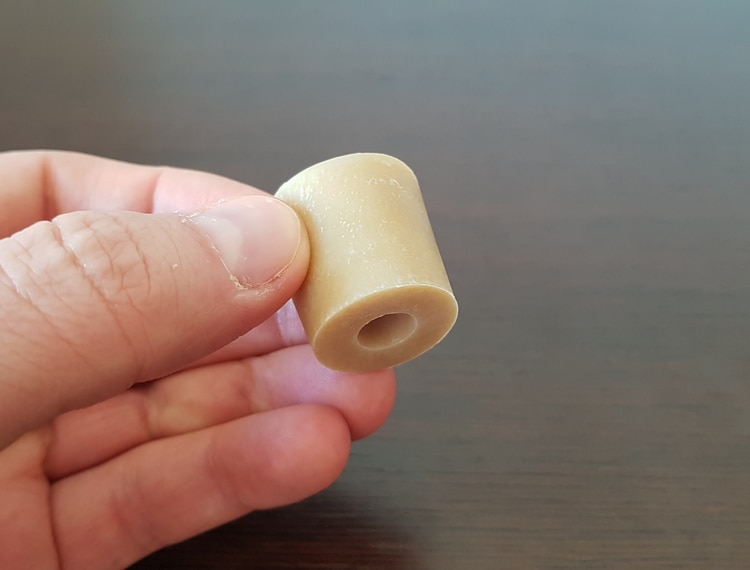
Adding Water or Sanitizer to Your Airlock
Both types of airlocks, the s-shaped and three-piece, need to be partially filled with water to provide a proper gas barrier.
How much water do you need?
In an s-shaped airlock, you should fill the middle “bubbles” of the s-shape with enough water for both to be about one-third full.
You may need to tilt the airlock to get the water to snake through the bends. Expect that some water will leak out as you try to get the water to move through to the second chamber.
In a three-piece airlock, you may see a recommended fill line. If so, make sure that you add water up to that fill line.
Otherwise, fill the base about half full, at least enough that the bottom edge of the piston is below the waterline.
However, some brewers recommend against using water in the airlock at all.
Instead, they recommend food-grade sanitizers, such as most homebrewer’s favorite Star-San, or even high proof alcohol.
Once a brewmaster told me he himself uses vodka.
Tap water may run the risk of having some contaminants in it.
If the fermenter ever sucked the liquid in the airlock back into the fermenter, the tap water might spoil the batch. Star-San or high proof alcohol would be less likely to cause contamination.
Checking on Your Airlock
If the environment around your fermenter is especially dry, such as a house with low humidity or draft, the water or liquid in the airlock could evaporate over time.
Be sure to check on the airlock periodically to make sure that nothing managed to get into it, such as a bug or foam from the fermentation process, but also to make sure that the water level is high enough.
You may need to add additional water or sanitizer to the airlock to ensure a proper seal is maintained.
When Do You Need an Airlock?
Any time you plan to ferment, you’ll need an airlock.
Airlocks are not only for brewing beer but can be used for any type of brewing, such as wine, mead, or cider. Even fermenting pickles, or pickling any type of fruit or vegetable, should be done with an airlock.
With brewing beer, you typically have multiple stages of fermentation.
During primary fermentation, the yeast is typically eating a majority of the sugar to create alcohol. Fermentation is the most active during the primary stages, often causing foam. This foam is called krausen.
It’s not uncommon for the krausen to foam up so much as to push up into the airlock, displacing any liquid within, then reducing back down, only to leave your airlock dry.
If you see the foam rising up in your fermenter, you may want to exchange the airlock for a blow off setup.
Using A Blow Off Setup
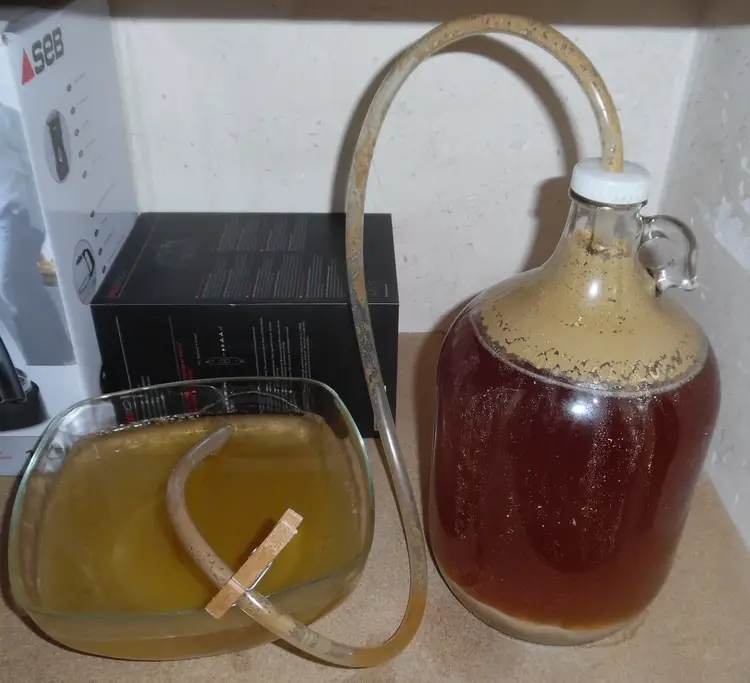
A blow off setup includes a food-grade tube with one tube inserted into the mouth of the fermenter and the other into a bucket of water or sanitizer.
This method effectively keeps ambient air out of the fermenter while also providing plenty of length of tube for the foam to bubble up.
During the very early, active stages of primary fermentation, if you have a narrow mouth fermenter, some brewers say that an airlock may not be necessary.
However, this may be true for only the first few days when fermentation is very active, such that the carbon dioxide processed inside is maintaining a positive pressure at the mouth.
This positive pressure may keep the outside air out of the vessel.
However, when fermentation is slower, it’s far safer to keep an airlock in the fermenter.
This is especially true if you have a secondary fermentation.
Since most of the fermentation occurs during the primary fermentation, the secondary fermentation may look tame by comparison.
You may be tempted to cap the fermenter completely. However, since the yeast may still be slowly active, pressure will gradually build up over time. While the vessel may not explode, some of this carbon dioxide may remain dissolved in the beer, potentially carbonating the beer earlier than planned.
Can You Brew Beer Without an Airlock?
Before the invention of airlocks, brewers made beer in open containers.
With this method, however, the beers risked contamination from wild yeast and bacteria in the air. While some styles cater to this type of contamination, such as Belgians, Sours, and Saisons, other beers require more pure fermentation to achieve the correct flavor.
If you don’t have a real airlock, you can fashion one temporarily with a few household items. You’ll need some plastic wrap or a plastic food storage bag, large enough to cover the mouth of your fermenter, and a rubber band.
Loosely cover the mouth of your fermenter with the plastic wrap.
The plastic wrap or bag should be sterile, fresh from the box, in order to keep any cross-contamination from spoiling your brew.
Secure the plastic wrap with the rubber band, but be sure to leave plenty of room for the plastic to expand.
If the wrap is too tight, the pressure in the vessel may burst the wrap.
Similar to this option, you could also use a balloon, latex glove, or other expandable/stretchable rubber or latex device.
The opening of the balloon should stretch over the mouth of the fermenter, but if it doesn’t, you can secure it with a rubber band.
Another option includes using the blow off setup described earlier. With one end of the tube in the fermenter and another in a bucket of water or sanitizer, the tube works similar to the stem of the airlock, just the level of water is much taller.
Open fermentation without airlock
That being said, there are many brewers that enjoy the process of open fermentation. Beer and Brewing gives four reasons why open fermentation may be desirable:
- Trying a hand at traditional brewing methods
- To maintain healthy yeast through removing krausen
- For intentionally exposing the beer to oxygen for specific flavors
- Allowing certain gasses to be relieved during the brewing process
If you want to pursue the traditional open fermentation method, make sure you use a wide, shallow vessel, place the wort in a clean, safe place in your house, and avoid drafts.
You may want to provide a loss cover on the vessel, such as a cloth supported by boards or dowels over the vessel’s top.
Keep sanitization as much of a priority as during normal fermentation with an airlock and rack your wort into a sealed fermenter with an airlock during secondary fermentation.
Remember that fermenting without an airlock opens up many risks of infection and contamination, but you may end up with a beer that is unique in flavor.
Be open to having less control over the outcome of the final beer.
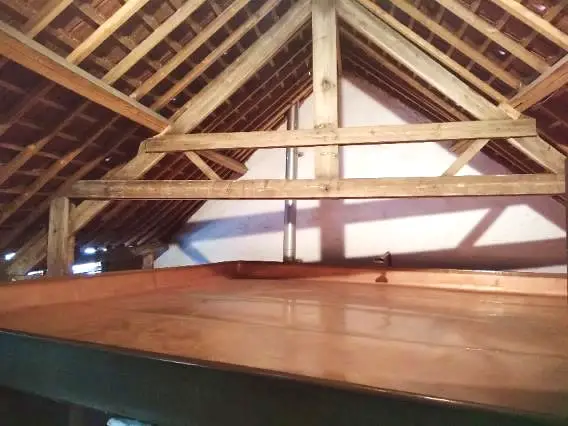
Conclusion
Keep in mind that the use of airlocks is strongly encouraged in modern beer brewing practices.
Airlocks help the brewing maintain a clean, sterile, controlled environment for their beer, reduces the possibility of oxidation, and allows the fermenter to relieve pressure from the buildup of carbon dioxide.
Airlocks, rubber stoppers, and other brewing supplies are widely available from online retailers and are worth the cost for any and all homebrewers.
As you shop for your ingredients for your next batch of brew, make sure you put an airlock on your shopping list.
Last update on 2024-10-08 / Affiliate links / Images from Amazon Product Advertising API
